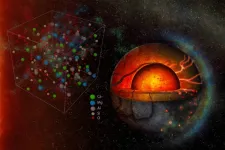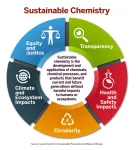(Press-News.org) ITHACA, N.Y. – While analyzing data from the first images of a well-known early galaxy taken by NASA’s James Webb Space Telescope (JWST), Cornell University astronomers discovered a companion galaxy previously hidden behind the light of the foreground galaxy — one that surprisingly seems to have already hosted multiple generations of stars despite its young age, estimated at 1.4 billion years old.
“We found this galaxy to be super-chemically abundant, something none of us expected,” said Bo Peng, a doctoral student in astronomy, who led the data analysis. “JWST changes the way we view this system and opens up new venues to study how stars and galaxies formed in the early universe.”
Peng is the lead author of “Discovery of a Dusty, Chemically Mature Companion to z~4 Starburst Galaxy in JWST Early Release Science Data,” published in the Astrophysical Journal Letters.
Earlier images captured by the Atacama Large Millimeter/submillimeter Array (ALMA) in Chile contained hints of the companion resolved clearly by JSWT, but couldn’t be interpreted as anything more than random noise, said Amit Vishwas, a research associate at the Cornell Center for Astrophysics and Planetary Sciences (CCAPS) and the paper’s second author.
The team estimated the companion galaxy, which they labeled SPT0418-SE, was within 5 kiloparsecs of SPT0418-47, one of the brightest dusty, star-forming galaxies in the early universe, its distant light bent and magnified by a foreground galaxy’s gravity into a circle, called an Einstein ring. The Magellanic Clouds, satellites of the Milky Way are about 50 kiloparsecs away. The proximity suggests these galaxies are bound to interact with each other and potentially even merge, an observation that adds to the understanding of how early galaxies may have evolved into larger ones.
The two galaxies are modest in mass as galaxies in the early universe go, with “SE” relatively smaller and less dusty, making it appear bluer than the extremely dust-obscured ring. Based on images of nearby galaxies with similar colors, the researchers suggest that they may reside “in a massive dark-matter halo with yet-to-be-discovered neighbors.”
Most surprising about the companion galaxy, considering its age and mass, was its mature metallicity – amounts of elements heavier than helium and hydrogen, such as carbon, oxygen and nitrogen. The team estimated that as comparable to our sun, which is more than 4 billion years old and inherited most of its metals from previous generations of stars that had 8 billion years to build them up.
“We are seeing the leftovers of at least a couple of generations of stars having lived and died within the first billion years of the universe’s existence, which is not what we typically see,” Vishwas said. “We speculate that the process of forming stars in these galaxies must have been very efficient and started very early in the universe, particularly to explain the measured abundance of nitrogen relative to oxygen, as this ratio is a reliable measure of how many generations of stars have lived and died.”
For additional information, see this Cornell Chronicle story.
Cornell University has dedicated television and audio studios available for media interviews.
-30-
END
Astronomers discover metal-rich galaxies in early universe
2023-02-27
ELSE PRESS RELEASES FROM THIS DATE:
Climate trends in the west, today and 11,000 years ago
2023-02-27
People often say things like Phoenix has always been dry; Seattle has always been wet; and San Francisco has always been foggy. But “always” is a strong word.
A study from the University of California, Davis, synthesizes climate trends across the Western U.S. during a relatively young period of Earth’s history — the Holocene Era, which stretches from the present day to the past 11,000 years. This look at the really Old West shows that the hallmarks of California’s climate — the foggy coastlines ...
Mysteries of the Earth: FSU researchers predict how fast ancient magma ocean solidified
2023-02-27
Early in the formation of Earth, an ocean of magma covered the planet’s surface and stretched thousands of miles deep into its core. The rate at which that “magma ocean” cooled affected the formation of the distinct layering within the Earth and the chemical makeup of those layers.
Previous research estimated that it took hundreds of million years for that magma ocean to solidify, but new research from Florida State University published in Nature Communications narrows these large uncertainties down to less than just a couple of million years.
“This magma ocean has been an important part of Earth’s history, and this study helps us answer ...
The Texas Heart Institute delivers a new first in heart failure treatment using cell therapy
2023-02-27
Houston, TX – February 27, 2023 – Physician-scientists at The Texas Heart Institute announced today the results of the largest cell therapy trial to date in patients with chronic heart failure due to low ejection fraction. The therapy benefited patients by improving the heart’s pumping ability, as measured by ejection fraction, and reducing the risk of heart attack or stroke, especially in patients who have high levels of inflammation. Also, a strong signal was found in the reduction of cardiovascular death in patients treated with cells. The findings ...
Augmented reality headset enables users to see hidden objects
2023-02-27
MIT researchers have built an augmented reality headset that gives the wearer X-ray vision.
The headset combines computer vision and wireless perception to automatically locate a specific item that is hidden from view, perhaps inside a box or under a pile, and then guide the user to retrieve it.
The system utilizes radio frequency (RF) signals, which can pass through common materials like cardboard boxes, plastic containers, or wooden dividers, to find hidden items that have been labeled with RFID tags, which reflect ...
How common is face blindness?
2023-02-27
How Common Is Face Blindness?
Study suggests condition affects more people than previously thought
For Immediate Release
Media Contacts:
Dennis Nealon
Dennis_Nealon@hms.harvard.edu
508-494-6117
Ekaterina Pesheva
Ekaterina_Pesheva@hms.harvard.edu
617-432-0441
At a Glance:
Study by researchers at Harvard Medical School/VA Boston Healthcare System suggests that face blindness lies on a continuum and may be more common than currently believed.
The study found similar face matching performance between prosopagnosics diagnosed with stricter vs. looser criteria, suggesting that the diagnostic criteria should be expanded.
As many as ...
Midwifery care safe for moderate- and high-risk pregnancies
2023-02-27
New UBC research shows that midwives in British Columbia are providing safe primary care for pregnancies of all medical risk levels, contrary to a popular belief that midwives mostly manage low-risk pregnancies.
The study, published in the Canadian Medical Association Journal, examined a decade of births in B.C. between 2008 and 2018. The researchers compared birth outcomes for people who had a midwife as their most responsible provider (MRP), with those who were cared for by a family physician or obstetrician.
The findings reveal that people who had a ...
Sustainable chemistry experts create blueprint for safer future
2023-02-27
Feb. 27, 2023
Media contacts:
Emily Gowdey-Backus, director of media relations, Emily_GowdeyBackus@uml.edu
Nancy Cicco, assistant director of media relations, Nancy_Cicco@uml.edu
Sustainable chemistry experts create blueprint for safer future
Group to share its work during free UMass Lowell webinar on March 1
Toxic chemicals – which pop up in everything from household cleaners and appliances to medical devices, paints, packaging and more – are all around. The February ...
Early-life stress can disrupt maturation of brain’s reward circuits, promoting disorders
2023-02-27
Irvine, Calif., Feb. 27, 2023 — A new brain connection discovered by University of California, Irvine researchers can explain how early-life stress and adversity trigger disrupted operation of the brain’s reward circuit, offering a new therapeutic target for treating mental illness. Impaired function of this circuit is thought to underlie several major disorders, such as depression, substance abuse and excessive risk-taking.
In an article recently published online in Nature Communications, Dr. Tallie Z. Baram, senior author and UCI Donald Bren Professor and Distinguished Professor in the Departments of Anatomy & Neurobiology, ...
Cedars-Sinai’s efforts to combat lower back pain get $2 million boost from CIRM
2023-02-27
Investigators at Cedars-Sinai have received a $2 million grant from the California Institute for Regenerative Medicine (CIRM) to develop a new cell therapy that helps improve quality of life for patients with degenerated discs and chronic lower back pain.
Dmitriy Sheyn, PhD, assistant professor in the departments of Orthopaedics, Surgery and Biomedical Sciences at Cedars-Sinai leads this new project in collaboration with Debiao Li, PhD, director of the Biomedical Imaging Research Institute and professor of Biomedical Sciences and Imaging at Cedars-Sinai; and Hyun Bae, MD, professor of Orthopaedics and co-medical ...
Amazon develops algorithm to improve collaboration between robots and humans
2023-02-27
New Study Key Takeaways:
A new algorithm is identified to allow robots and humans to work together efficiently and profitably.
Robots bring shelves of inventory to associates to pick for customer orders.
The adoption of the algorithm cuts down on distance traveled by pods as well as the storage footprint for the company.
The fulfillment operation with the new algorithm results in a half a billion dollars in savings.
BALTIMORE, MD, February 27, 2023 – Amazon has identified a financially beneficial way for robots and humans to coexist, and it’s saving the online enterprise half a billion dollars per year. Using robots to bring ...




